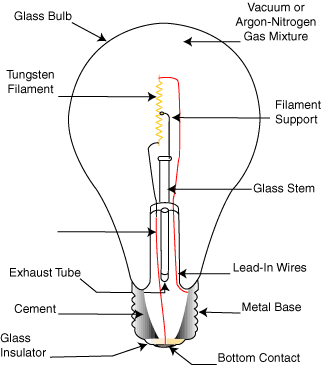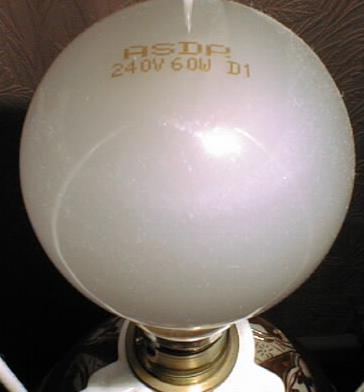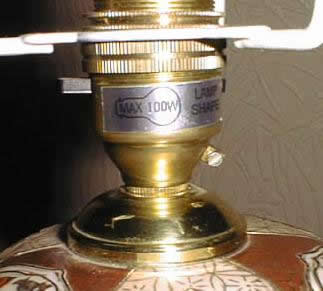The
Electric Light Bulb
Electric light bulbs like this are very wasteful when used as a light source. About 95% of the electrical energy is changed into heat - not the required form - light! In modern houses they have been replaced by energy saving bulbs.

|
Tungsten Filament
|
This is the main
working part of a lightbulb. It is a heating element that gets
so hot that it emits light. It is made of tungsten as it does
not reach its melting point and evaporates very little at the
typical filament operating temperatures of 2,000oC
. |
|
Vacuum or Gas
Fill
|
This is to prevent
oxidation of the tungsten. If an inert gas fill is used, it
is usually a mixture of argon and nitrogen. Argon is an inexpensive
inert gas that conducts heat less than nitrogen does. Destructive
electric arcs form easily in pure argon, so nitrogen is added
to keep arcs from forming easily. A gas fill is better than a
vacuum as it slows down evaporation of the filament. Gas atoms
can "bounce" atoms of evaporated tungsten back onto the filament.
So with a gas fill, the filament lasts longer and can be operated
at a higher temperature. This allows it to give off more light. A
gas fill has the disadvantage of conducting heat from the filament
but the advantages of a gas fill usually outweigh the disadvantages
for power ratings of above 40W.A few lightbulbs have premium
gas fills using krypton or xenon, which conduct heat less than
argon does and reduce filament evaporation more than argon does,
but these are more expensive. |
|
Glass Bulb
|
This is the main
structural part and keeps the gas or vacuum in and the air out. |
|
Filament Support(s)
|
Many but not all
incandescent lamps have these. The filament supports keep the
filament from bending out of shape from its own weight or from
shock and vibration. Filament supports are usually made of molybdenum
since this metal is easily worked into glass and it has a very
high melting point. |
|
Base
|
This is where
electrical contact is made. |
|
Fuse Wire
|
Most bulbs have
this as a built-in fuse in case an arc forms. If an arc forms
and there is no fuse wire inside the bulb, the arc can draw
enough current to trip a breaker or blow a fuse in the fusebox
or damage a light dimmer. The presence of this fusewire allows
any overload to be 'dealt with' within the bulb itself. |
|
Lead-In Wires
|
These connect
the filament to the base. |
|
Stem
|
This is an internal
piece of glass that is welded to the bulb. It holds the lead-in
wires and any filament supports. (labelled diagram
adapted with permission from
www.bulbs.com
)
|
The
light bulb contains a coiled filament of metal with a high melting point.
The coil is sealed in a glass tube that is filled with a mixture of
inert gases such as argon and nitrogen instead of air. When metals are
heated in air they are oxidised (react with the oxygen in the air) and
produce oxides of the metal, which are often in powder form, and not
conductors of electricity. When the lamp is turned on, a current flows
through the filament and it glows. It gets very hot very quickly and
reaches a very high temperature. The inert gases are present to prevent
combustion occurring. This would oxidise the metal filament, turn it
into the powdery non-conducting oxide and make it unable to conduct
electricity any more.
 A light bulb circuit needs
of source of electric energy that provides a potential difference (voltage)
across the light bulb. It doesn't matter whether this is a DC supply
(direct current) like a battery or an AC supply (alternating current)
like the mains. Both will make the lamp filament wire get hot and glow.
You have to be careful about the size of the potential difference the
power supply provides. If it is too small the bulb will hardly glow
at all. If it is too large the bulb filament will get too hot and melt
(the bulb will blow!). The bulb does not 'blow up' but the rapid air
expansion due to the heat energy produced when the high current passes
through the wire sometimes is heard as a 'BANG' and we say it 'blows'.
If you look carefully at a light bulb you will find the working voltage
stamped into the metal at the base of the bulb or etched into the glass
bulb itself. The power of the bulb is usually also written there.
A light bulb circuit needs
of source of electric energy that provides a potential difference (voltage)
across the light bulb. It doesn't matter whether this is a DC supply
(direct current) like a battery or an AC supply (alternating current)
like the mains. Both will make the lamp filament wire get hot and glow.
You have to be careful about the size of the potential difference the
power supply provides. If it is too small the bulb will hardly glow
at all. If it is too large the bulb filament will get too hot and melt
(the bulb will blow!). The bulb does not 'blow up' but the rapid air
expansion due to the heat energy produced when the high current passes
through the wire sometimes is heard as a 'BANG' and we say it 'blows'.
If you look carefully at a light bulb you will find the working voltage
stamped into the metal at the base of the bulb or etched into the glass
bulb itself. The power of the bulb is usually also written there.

The light bulb filament
is a coil of wire which acts as a resistor. It is coiled so that the
wire can get very hot and glow (produce light). Heat is produced when
a current passes through a wire. It is radiated to the surroundings
and absorbed by air molecules that are near to the wire. These carry
away the heat in convection currents  Most of the time we do not want
electrical wires to get hot. When they are hot theirresistance increases
and this can affect the way a piece of electrical equipment works. Therefore
we design electrical equipment casing with cooling fins and vents to
allow the heat energy to quickly dissipate (get shared out) to the surroundings.
A light bulb filament needs to be hot, in fact we need it so hot
that it glows! Therefore we do the opposite. We coil the wire round
and round making it difficult for the pockets of hot air to escape and
making the resistance of the filament even greater. Another reason why
the filament is curled into a coil is so that a great length of glowing
wire can be concentrated in a small space, making a more concentrated
light source.
Most of the time we do not want
electrical wires to get hot. When they are hot theirresistance increases
and this can affect the way a piece of electrical equipment works. Therefore
we design electrical equipment casing with cooling fins and vents to
allow the heat energy to quickly dissipate (get shared out) to the surroundings.
A light bulb filament needs to be hot, in fact we need it so hot
that it glows! Therefore we do the opposite. We coil the wire round
and round making it difficult for the pockets of hot air to escape and
making the resistance of the filament even greater. Another reason why
the filament is curled into a coil is so that a great length of glowing
wire can be concentrated in a small space, making a more concentrated
light source.
have a maximum power rating indicated on them. If you fit a bulb with
a bigger power rating than this the wiring within the lamp base will
get too hot and it may be a fire risk.
have a maximum
power rating indicated on them when you buy them. This is usually a
little paper tag. If you fit a bulb with a bigger power rating than
this too much heat may be produced for the shade, it may get hot and
catch fire. You should always look carefully at instructions with a
new appliance.





 A light bulb circuit needs
of source of electric energy that provides a potential difference (voltage)
across the light bulb. It doesn't matter whether this is a DC supply
(direct current) like a battery or an AC supply (alternating current)
like the mains. Both will make the lamp filament wire get hot and glow.
You have to be careful about the size of the potential difference the
power supply provides. If it is too small the bulb will hardly glow
at all. If it is too large the bulb filament will get too hot and melt
(the bulb will blow!). The bulb does not 'blow up' but the rapid air
expansion due to the heat energy produced when the high current passes
through the wire sometimes is heard as a 'BANG' and we say it 'blows'.
If you look carefully at a light bulb you will find the working voltage
stamped into the metal at the base of the bulb or etched into the glass
bulb itself. The power of the bulb is usually also written there.
A light bulb circuit needs
of source of electric energy that provides a potential difference (voltage)
across the light bulb. It doesn't matter whether this is a DC supply
(direct current) like a battery or an AC supply (alternating current)
like the mains. Both will make the lamp filament wire get hot and glow.
You have to be careful about the size of the potential difference the
power supply provides. If it is too small the bulb will hardly glow
at all. If it is too large the bulb filament will get too hot and melt
(the bulb will blow!). The bulb does not 'blow up' but the rapid air
expansion due to the heat energy produced when the high current passes
through the wire sometimes is heard as a 'BANG' and we say it 'blows'.
If you look carefully at a light bulb you will find the working voltage
stamped into the metal at the base of the bulb or etched into the glass
bulb itself. The power of the bulb is usually also written there.
 Most of the time we do not want
electrical wires to get hot. When they are hot theirresistance increases
and this can affect the way a piece of electrical equipment works. Therefore
we design electrical equipment casing with cooling fins and vents to
allow the heat energy to quickly dissipate (get shared out) to the surroundings.
A light bulb filament needs to be hot, in fact we need it so hot
that it glows! Therefore we do the opposite. We coil the wire round
and round making it difficult for the pockets of hot air to escape and
making the resistance of the filament even greater. Another reason why
the filament is curled into a coil is so that a great length of glowing
wire can be concentrated in a small space, making a more concentrated
light source.
Most of the time we do not want
electrical wires to get hot. When they are hot theirresistance increases
and this can affect the way a piece of electrical equipment works. Therefore
we design electrical equipment casing with cooling fins and vents to
allow the heat energy to quickly dissipate (get shared out) to the surroundings.
A light bulb filament needs to be hot, in fact we need it so hot
that it glows! Therefore we do the opposite. We coil the wire round
and round making it difficult for the pockets of hot air to escape and
making the resistance of the filament even greater. Another reason why
the filament is curled into a coil is so that a great length of glowing
wire can be concentrated in a small space, making a more concentrated
light source.


